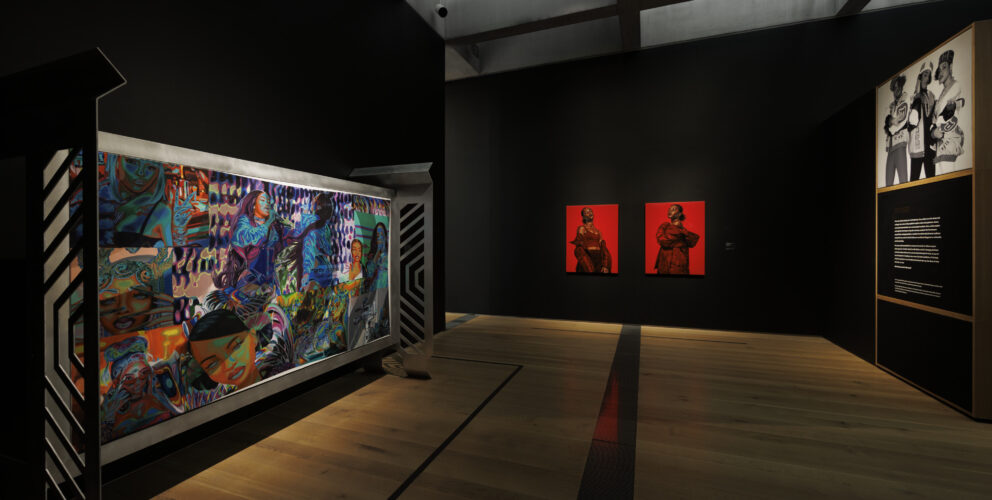As part of the Five Pillars of Hip Hop in Community Engagement Initiative, a mural was unveiled at St. Louis ArtWorks after a 13-week graffiti residency.
Community engagement, access critical to formation of multidisciplinary exhibition
Not all exhibitions are created in the same way.
Some originate with a single piece of art that helps tell a larger cultural story. Other exhibitions are the brainchild of a curator’s scholarly expertise relating to a particular artist or genre. Some focus on a historical moment, others on visual beauty.
And some exhibitions are so much bigger than one person or even one institution can conceptualize from inside a museum’s walls alone. The Culture: Hip Hop and Contemporary Art in the 21st Century is one of those exhibitions where the origin story is integral to what’s seen inside the galleries.
Organized by SLAM and the Baltimore Museum of Art, The Culture presents a sweeping art history of hip hop culture and its myriad expressions across the globe. The multidisciplinary and multimedia exhibition was developed as a collaborative effort, engaging both museums’ curatorial and education departments with an emphasis on community access.

A global advisory group met in person and via Zoom while planning The Culture.
Throughout the planning for this exhibition, SLAM and the BMA engaged a global advisory group of academics, musicians, fashion designers, visual artists, and museum curators who informed the direction of the catalog, exhibition, and related programming. This thoughtful and diverse group helped guide a process of open dialogue about the project, sharing valuable insights and suggestions.
The group of about 20 individuals met virtually and in person a total of three times, including at the Clark Art Institute Exhibition Concept Workshop in Williamstown, Massachusetts. Two St. Louisans were part of the group: Tef Poe, a local rapper, educator, journalist, and activist; and Damon Davis, a multimedia artist, musician, and filmmaker whose work is featured in the exhibition.
“At the workshop, the group discussed ways in which hip hop bridges popular culture, street culture, and art institutions covering grounds not yet addressed by existing art histories of hip hop,” said Andréa Purnell, SLAM’s audience development manager and cocurator of the exhibition. “These conversations helped refine themes of the exhibition and focused on exploring public programming that would adhere to the ethos of hip hop.”
In St. Louis an additional, regional group of individuals with connections to the arts, culture, health, and hip hop communities also convened locally to discuss key artworks under consideration and ways to make the exhibition accessible to the local community and beyond.
“Emerging in 1973 as an unabashed declaration of Black, Latinx, and Afro-Latinx difference, hip hop has always been a culture that reflects community,” Purnell said. “Now, with the 50th anniversary in 2023, hip hop is a dominant form of expression and subject of artistic production, embraced by communities from all walks of life.”

Harris-Stowe State University hosted a hip hop, mental health, and art-making event as part of the knowledge pillar in the Five Pillars of Hip Hop in Community Engagement Initiative.
As part of the St. Louis community engagement effort surrounding the exhibition, SLAM collaborated with five area organizations, with each responding to one of the five pillars of hip hop—emceeing (or rapping), DJ-ing, breakdancing, graffiti, and knowledge. DJ Afrika Bambaataa, one of the three godfathers of hip hop, which traces its origins to a 1973 party in the Bronx, is credited with creating the classification system meant to capture the original essence of hip hop.
The local collaborations aim to engage the community through multidisciplinary presentations, including dance, spoken word, visual art, music, and panel discussions. Programs and events led by collaborators and teaching artists will take place at the Museum and other locations throughout Greater St. Louis when The Culture is on view.
The partner organizations include St. Louis ArtWorks (graffiti pillar), Harris-Stowe State University (knowledge pillar), Kode REDD Dance (breakdancing pillar), St. Louis County Library (DJ pillar), and UrbArts Gallery (emcee pillar).
SLAM is also partnering with Harris-Stowe to employ students as engagement guides for The Culture. The students will be trained on exhibition content and visitor engagement and mentored by Museum docents.
As yet another piece of the exhibition that recognizes hip hop’s deep roots in the local community and its global reach, an interactive recording booth at the Museum will allow exhibition visitors to share their memories and personal stories of hip hop. The “For the Record” digital archive will travel to the exhibition’s future venues in the United States and internationally before finding a permanent home at the Atlanta University Center’s Robert W. Woodruff Library.
The Culture is cocurated by Hannah Klemm, SLAM’s former associate curator of Modern and Contemporary art; Andréa Purnell, SLAM’s audience development manager; Asma Naeem, BMA’s Dorothy Wagner Wallis Director; and Gamynne Guillotte, BMA’s chief education officer; with Rikki Byrd, BMA’s curatorial research fellow, and Carlyn Thomas, BMA’s curatorial assistant.
